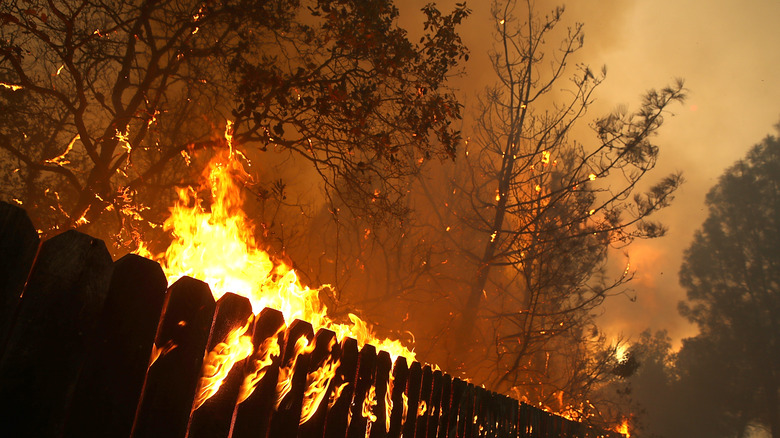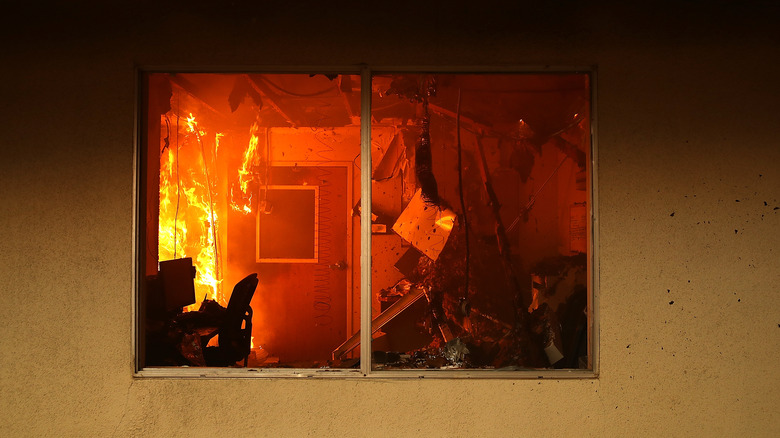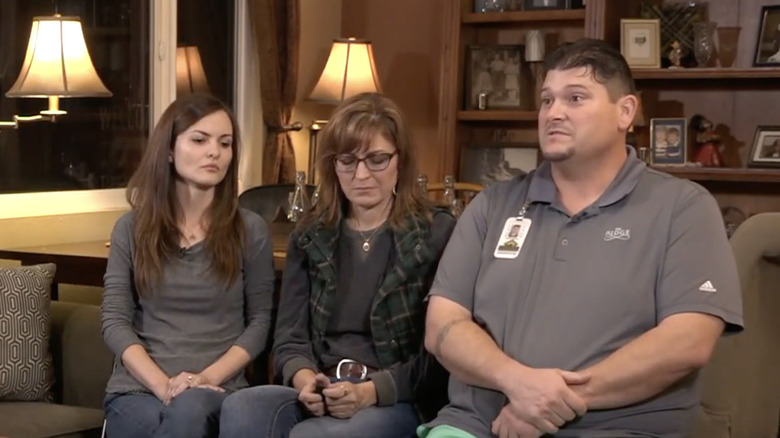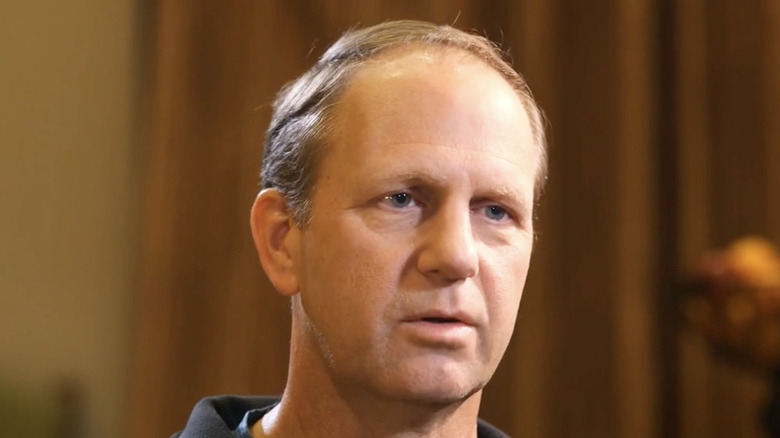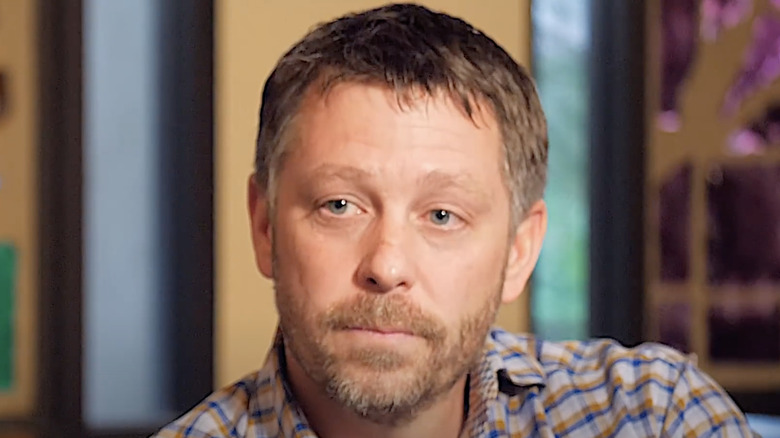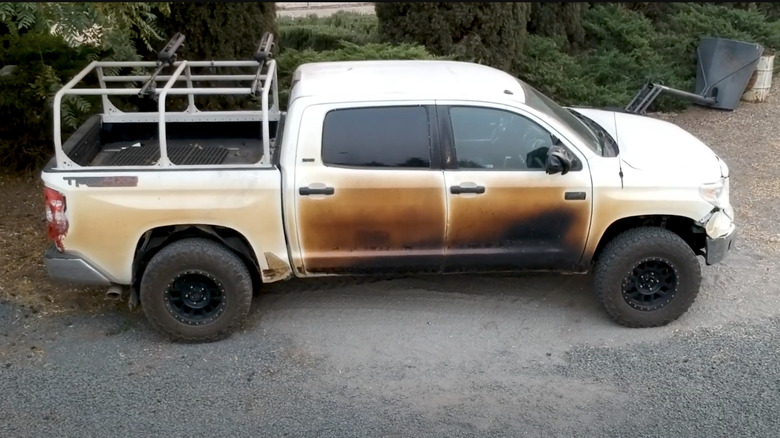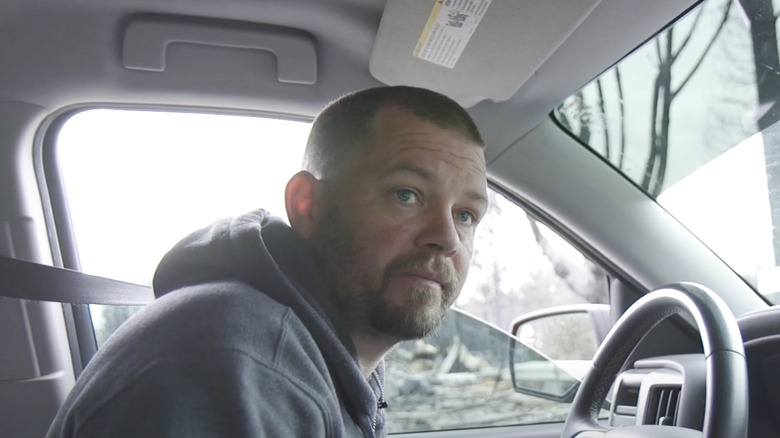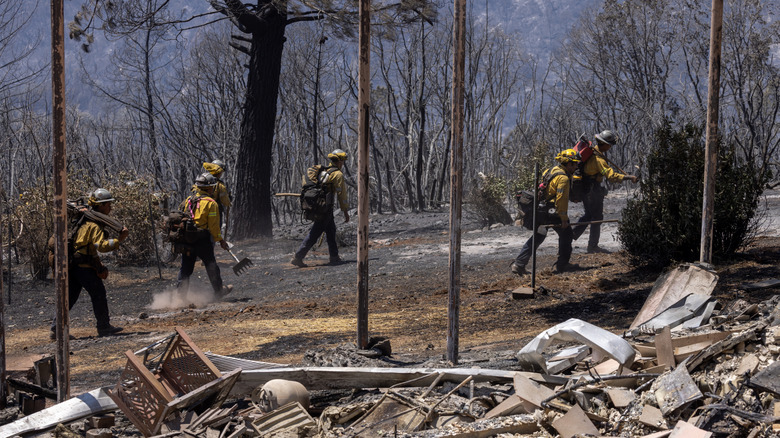The Story Of The Deadliest Wildfire In California History
California is no stranger to wildfires, and some trees, like giant sequoias, have even adapted to thrive in environments prone to fire. But tragically, little survived in the wake of the 2018 Camp Fire wildfire, which burned so quickly that it covered "a football field every second," per CNN. Several towns were absolutely devastated by the fire and as thousands scrambled to evacuate, scores of people lost their lives to the encroaching flames.
While intense winds and low humidity fueled the fire, the tragedy was ultimately revealed to be man-made. Meanwhile, the company responsible ended up facing criminal charges for its role in the fire, which was the first time that any major utility company pleaded guilty to 84 counts of involuntary manslaughter and one count of unlawfully starting a fire.
The investigation into the wildfire would find that many of the decisions that led to the 2018 Camp Fire wildfire were made up to 40 years before the wildfire. But some of the issues were almost 100 years old. In the end, considering the reckless behavior of the company, the failure that resulted was clearly a "not if but when" scenario, and the disaster is now one of the most destructive wildfires in history.
The Camp Fire wildfire begins
At around 6:15 a.m. on the morning of November 8, 2018, the Pacific Gas & Electric (PG&E) Grid Control Center noted an "interruption" on one of their Caribou-Palermo lines near Pulga, California. Later, Cal Fire investigators would determine that the interruption was caused by a failed C-hook, which led to molten aluminum and steel falling to the dry brush on the ground and starting a fire. According to Butte County's Camp Fire Public Report, a second fire started 2.6 miles west of the first fire and ignited when a ponderosa pine tree fell onto and broke a distribution line. The second fire was soon engulfed by the first blaze but ultimately had "little, or no, effect on the Camp Fire."
According to the Bulletin of the American Meteorological Society, the strong northeasterly winds allowed the fire to easily expand, and within two hours, it reached the northeast border of the town of Paradise. In the first 24 hours alone, the fire raged through 70,000 acres of land. In the end, it took 17 days to contain the wildfire. By that point, the wildfire had burned through almost 154,000 acres.
At the time, imprisoned people who act as firefighters "outnumbered California's seasonal firefighters more than two-to-one," according to Frontline. And while typically their work entailed cutting down fences and clearing brush, during the 2018 Camp Fire wildfire, they instead had to contend with "burning buildings and a chaotic evacuation."
A deadly and destructive tragedy
The 2018 Camp Fire wildfire in California remains, as of the time of this writing, the deadliest and most destructive wildfire in the history of California. Per the Camp Fire Public Report, eighty-four people died as a result of the man-made disaster, one of the worst in history, and there were three people — two civilians and one firefighter— who suffered severe injuries. One person, Sara Martinez-Fabila, was never found after the Camp Fire wildfire, and to this day, years later, she is still missing.
According to CNBC, over 18,800 structures were destroyed in the fire across several towns. And towns like Paradise, which had a population of 27,000, were almost entirely burnt to the ground, as were the neighboring towns of Concow and Magalia. The disaster also ended up being incredibly costly. German insurance company Munich Re reported that the wildfire caused $16.5 billion in overall losses. And for many of the survivors, there was little relief even after the fires had subsided. Despite some aid being made available from the state and federal government and nonprofits, they would require paperwork that existed only as ash in a burnt-down town. "Others found themselves missing deadlines for aid that they never even knew existed until it was too late," Vox writes. And one survivor told that outlet that for those without renter's insurance, there was "literally nowhere to go."
PG&E pleads guilty
In 2019, an investigation led by the Butte County district attorney found that the 2018 Camp Fire wildfire was caused by PG&E's outdated power lines, faulty maintenance, and failure to follow state regulations, according to NPR. The Camp Fire Public Report found that the C-hook that broke was "at least 97 years old." And because PG&E had no records of said hook, they didn't even know what type of metal the C hook was made out of. "The fact that PG&E was using a 97-100-year-old conductor for which they knew almost nothing is evidence of absolute indifference on the part of PG&E," the report stated.
After facing criminal charges of 84 counts of involuntary manslaughter and one felony count of unlawfully starting a fire, PG&E pled guilty to every single charge on June 16, 2020, in addition to waiving the company's right to appeal. As part of the plea deal, PG&E was ordered to pay a fine of $3.5 million as well as a $25.5 billion settlement to compensate "victims, their families, and Butte County agencies," per NPR.
This also wasn't the first fire caused by PG&E. Business Insider reports that between 2013 and 2019, PG&E power lines caused over 1,500 wildfires in California. In 2020, the California Public Utilities Commission also imposed a $1.93 billion penalty — its largest ever — on PG&E for the wildfires it caused between 2017 and 2018.
A driver and two teachers saved a bus load of children
Only a few months before the Camp Fire, Kevin McKay started work as a bus driver for Ponderosa Elementary School in Paradise. On the day of the fires, the school evacuated all but 22 students whose parents hadn't been able to come get them. After clearing it with the principal, McKay volunteered to drive the kids, along with teachers Abbie Davis and Mary Ludwig, to a safe spot.
It wasn't easy. McKay drove the bus and its 24 passengers through smoke-choked roads until it got stuck in an unmoving lineup of cars attempting to leave Paradise. He also had to drive around small fires that had ignited on the roads, and at one point, the bus was hit by a car. The vehicle also added a passenger, rescuing a preschool teacher whose car had stopped working from the neighboring town of Biggs.
Davis and Ludwig did their best to keep up the spirits of the 22 kids onboard, offering emotional support and makeshift breathing apparatuses. When the bus filled with smoke, McKay removed one of his shirts, which the teachers tore into chunks and doused with the one bottle of water on the bus. They distributed them to the children while establishing a buddy system in the event of bus abandonment and demonstrating how emergency exits and the fire extinguisher worked. After five hours of all that, McKay got the bus full of children and teachers out of harm's way.
A nurse braved the flames to evacuate multiple people
The staff and patients of the Feather River Hospital in Paradise, California, evacuated as quickly as possible and with very little notice to escape the fast-moving Camp Fire in 2018. They did it together, too, with nurses leaving the area in their personal vehicles that they opened up to as many patients as possible. Darrell Wilken, a nurse at Feather River Hospital, participated in the get-out efforts, and he and his three passengers — two of them already listed in critical condition — almost didn't make it out. His vehicle was surrounded by flames as Wilken attempted to drive out of the Paradise area, adding intense heat to the situation that made the windows impossible to touch. The car very slowly made its way through the crowded roads and flames, passing cars that had caught fire. Resigned to death, Wilken and the three others all placed goodbye calls to their families.
After three hours of careful driving and waiting, the party was safely evacuated. "I didn't want to lose anybody," Wilken told CBS News. "We have not just an obligation to our patients, but we have an obligation to humanity. We have to do our jobs, regardless of adverse conditions.
A chaplain ferried ICU patients to safety
Brad Brown, the resident chaplain at the Feather River Hospital in Paradise, got to work on the morning of November 8, 2018, just after the fire-related evacuation of its patients had already begun. He quickly lent a hand, helping to get the most seriously ill patients into waiting ambulances that would transport them to other hospitals. But then there were no more ambulances, and patients remained. So, Brown pulled up his Honda Odyssey minivan and carefully gathered four passengers: The hospital's respiratory therapist, two intensive care unit patients, and another in hospice care placed in the back of the vehicle on a gurney pad.
For two hours, Brown's party was stuck in traffic on the road leaving the hospital. Cars around them had burned up, visibility was no more than 20 feet, and flames slapped up against the outside of the van. After the respiratory therapist couldn't handle the traumatic stress of waiting, she ran back to the hospital, opening up a free seat for a stranded motorist whose escape car had run out of gas. Brown spoke with his two teenage children on the phone for what he thought would be the last time — he didn't think he'd survive the journey. Then, finally, traffic started to move, and after awaiting instructions in a Kmart parking lot, Brown was directed to a hospital in Chico to drop off his patients.
A nurse saved so many she had to be saved herself
When nurse Nichole Jolly reported to work at the Feather River Hospital, it was right when patients were being evacuated. She got them into wheelchairs and out of the building, where they were driven off of the premises. It was only once everyone was gone that Jolly got in her car and attempted to leave the hospital herself. That proved impossible: Every path was blocked by flames.
As her car became inhospitable due to toxic smoke, Jolly called her husband to say goodbye to him and their children, a notion he refused. "He told me, 'Don't die. Get out of that car and run. Don't die,'" she told KTVU. Jolly took off, running down the road and through fire, which, at one point, caused her clothes to catch fire. She found temporary relief in a car belonging to a colleague, which they both had to abandon when it became overwhelmed with smoke.
Once more, Jolly ran through hot, smoky, barely visible air that offered little oxygen while her shoes gradually burned from the hot pavement. Just after she thought she couldn't go any further, she was rescued by a fire truck, which was on its way back to Feather River, which was still untouched by fire and treating the first patients injured by the disaster. Jolly performed emergency nursing duties for several more hours until she was evacuated.
A nurse manager drove through fire to evacuate coworkers
Even before local authorities delivered the evacuation order, Allyn Pierce saw the ominously dark and orange-colored sky in the early hours of November 8, 2018. An intensive care unit nurse manager at Feather River Hospital, Pierce had already started to get the facility's most vulnerable patients out the door. His patients were the first evacuees, and he was among the last to leave the hospital, making multiple checks of rooms to ensure that all of them had been removed and preparing rooms for anyone that would need to be treated for fire injuries later on. Only then did Pierce leave the grounds in his heavy-duty pickup truck, grabbing a few people that had no other way of leaving.
After encountering gridlock evacuation traffic, Pierce attempted to take a shortcut to a highway out of town by driving through a gully, which was aflame by the time he got there. Nevertheless, he soldiered on, pushing through the fires of the ravine amid burned cars and homes for a mile before he connected with a fire truck and left his passengers in the care of first responders. Pierce didn't really have anywhere to go by then, as abandoned cars were blocking the roads and the fires grew ever closer. So, with the flames melting and burning his vehicle around him, Pierce changed course and headed back to Feather River Hospital, where he aided in building a medevac helipad and an emergency treatment site in the parking lot.
Stephen Murray saved an entire trailer court's lives
On the morning of November 8, 2018, the Camp Fire that would destroy most of Paradise, California, began to descend on the town. Plenty of citizens were still sleeping, unaware of the encroaching danger or evacuation recommendations. That presented a significant danger to those who lived in the all-senior Apple Tree Village Mobile Home Park, and the complex's manager, Stephen Murray, acted fast, knocking on doors and helping to evacuate his charges.
Then it occurred to Murray that those who hadn't responded to his fervent knocking had slept through his warning. So, in every home that hadn't yet been emptied, Murray gained emergency access. "If people's cars were still in their driveways, I began kicking down doors," he told the Chico Enterprise-Record. Murray's quick thinking cleared the Apple Tree Village mobile park — he had a hand in saving the lives of all 287 residents. Once he arrived at his final evacuation spot of Reno, Nevada, he parked his pickup truck at a hotel to gather donated supplies and drove them back to the Paradise fire shelter in Chico.
Many people died because they couldn't evacuate their homes
Despite the heroic acts that saved hundreds of lives, 85 people died in the Camp Fire that ravaged Paradise, California and surrounding areas in 2018. Tragically, many died because getting away from the fires in a timely fashion was difficult or nearly impossible. Joyce Acheson had difficulty walking, and the 78-year-old was found dead in her home, which was situated in an area inaccessible to the public. Rafaela Andrade, 84, required the use of a walker and couldn't flee fast enough, ultimately dying in her home. Sixty-five-year-old Vincent Carota, who lived with a partially amputated leg, didn't have access to a car, and he died in his residence. Herbert Alderman also died at home. The 80-year-old placed many calls to friends seeking rescue but was unable to get out on his own due to a seriously sprained ankle.
Julian Binstock, 88, had attempted to escape the toxic smoke of the fires in his shower with his dog. That's where they were found dead. The bodies of 40-year-old Christina Heffern, her 20-year-old daughter Ishka, and her 60-year-old mother Matilde were also discovered in a bathtub together. Gordon Dise, 66, died inside his residence in Butte Creek Canyon, a census-designated place near Chico. He'd successfully evacuated but then returned to the home to retrieve a possession and wasn't able to get out again.
Numerous people died while trying to flee the Camp Fire
Quite a few victims of the Camp Fire that struck the Paradise, California area did manage to leave their homes and seek safety, only to be killed by the effects of the fast-moving conflagration before they could fully evacuate. Richard Brown, 74, lay under his truck, which is where his body was found, while the remains of 78-year-old Marie Wehe were discovered in a truck not far from her home. Couple Robert Duvall and Beverly Powers died in separate vehicles while stuck in traffic, waiting to drive away. Also in that line were 72-year-old Joy Porter and her son, 49-year-old Dennis Clark Jr., who died trapped in a car.
Some victims had attempted to leave the area on foot. The body of Richard Garrett, 58, was later found in a grove of trees, while 69-year-old Sally Gamboa's body was discovered in a field adjacent to her home. TK Huff, who used a wheelchair following a leg amputation, died after he had reportedly attempted to move away from the fire by pulling himself on the ground.

